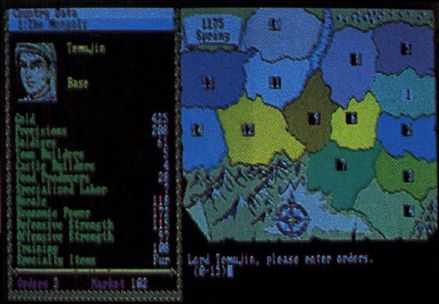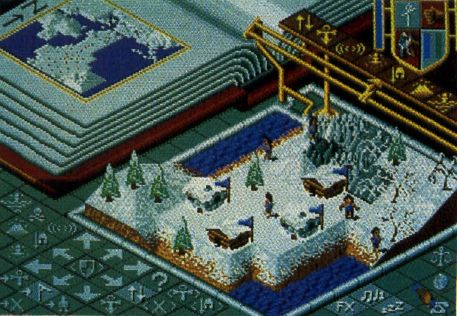PUT AWAY YOUR TOYS AND TAKE ON THE WORLD
GROW UP!
DENNY ATKIN
You're an adult now, and along with that title comes responsibility. Unless you're Alexander Haig, you probably get a slight chill down your back when you have to say "I'm in control here." Well, the COMPUTE! Leadership Academy has just the course for you. By the time you've finished our rigorous training program, world leaders will be calling you for advice.
The academy isn't hard to get into. A quick trip to the local software store to gather your courseware and you're all set. So, boot up your home computer and prepare to enter a world of action, intrigue, politics, and mysticism.

The Khan Job
Before you can be a great leader, Grasshopper, you must study the mistakes and triumphs of those who came before you. Start your training by playing Koei's Genghis Khan. This war game puts you in the role of Temujin, the twelfth-century Mongol chief who started life abandoned and impoverished but went on to rule most of Eurasia as the feared Genghis Khan. Note that an EGA or a VGA monitor is a prerequisite for this portion of the course.
When you start Genghis Khan, choose skill level 1 (easiest). We don't want you failing out this early in the semester.
At first glance, the game's map may remind you of the board game Risk. There are 14 countries on the main screen; eventually, you must conquer all of them. However, unlike Risk, you can't just leap in and attack. You'll probably win your first couple of battles, but you'll have depleted your army. That makes you an easy target for quick conquest by your stronger neighbors.
First, build up your home country by trading goods with merchants, adjusting tax rates, and training your soldiers. A successful leader needs the support of the population, so you must give them goods, gold, and provisions to keep their morale up.
While you're boosting the local economy, you should prepare for combat. Using the Diplomacy command, you can call a five-year truce with another country or demand that a weaker country pay tribute to you. The Espionage menu lets you prepare for your battles by spying on your neighbors, sabotaging their economy, or trying to assassinate an enemy leader.
Once you've built up your army's strength and developed a strong enough economy to support a war effort, it's time to invade another country. Pick a bordering country that is weak militarily but strong economically so that you can boost your own wealth. You could send in one of your generals to lead the attack, but then you won't get any combat experience yourself, and that's part of this course.
The attack screen is laid out in a series of hexagons. Combat is typical of computer-based war games: Move your army next to the enemy and issue an attack command. You command cavalry, archers, and infantry, and each have unique strengths in combat. The battle ends when one side is destroyed or the enemy surrenders. If you win, you add that territory to your empire.
Once you've defeated a country, you can choose to rule it yourself or put one of your governor candidates in charge. Either way, you've gained yet another territory to defend and another economy to manage.
Genghis Khan is an excellent prerequisite to a real leadership experience because it forces you to gauge your resources before making decisions. Now that you've had a taste of civilian and military leadership, you're ready for your first real command.
In the Navy
Out of the past, and into the future: The country is on the verge of World War III. Because of your exceptional performance in the Genghis Khan historical simulation, you've been selected to enter a crash course in submarine command. So boot up MicroProse's Red Storm Rising, a fastpaced sub simulator based on Tom Clancy's best-selling novel, and get ready for some heated undersea battles.
Red Storm Rising puts you at the helm of a modern nuclear fast-attack submarine. Your targets are Russian submarines and destroyers that are hunting you down.
If you've played other sub simulators, forget everything you've learned. There's no surface combat here—usually you won't even get up to periscope depth. Modern submarine combat is controlled from sophisticated computer consoles. Avoiding electronically controlled torpedoes that can double-back and try again demands new combat strategies.
Your sub is armed to the teeth with torpedoes and three different types of cruise missiles. You'll need all of these weapons, too. You have to face 20 varieties of Warsaw Pact ships and 16 kinds of submarines, all with varying combat ability.

You need to read the manual before embarking on your first cruise. You have to learn when to order your crew to use active instead of passive sonar, when to use torpedoes instead of cruise missiles. That knowledge makes the difference between war heroes and shark food.
Don't plan on winning this World War III scenario in one sitting, though; the Soviets have a very large navy.
Campaign Trail Mix
You've completed Red Storm Rising, disabled the Soviet navy, and become a war hero. Now that you've been promoted to Admiral, you can retire from the Navy. But you're not ready to rest. The taste of leadership under pressure has made you ready to enter a vicious, bloodthirsty combat arena that makes the battles you saw in the Navy seem downright tranquil. That's right—you're going into politics. So boot up SSI's President Elect and hit the campaign trail.
With the 1988 version of President Elect, you can run against candidates ranging from Bush, Dukakis, Nixon, and Kennedy to Lee lac-coca and Gary Hart. You could replay a historical scenario (Ford vs. Carter) or try a hypothetical election face-off (Kennedy vs. Reagan). But since you're working on your leadership qualities here, you should throw your own hat into the ring.
You start by planning your campaign. First, select a year between 1960 and 1988 for your campaign. Factors such as unemployment and inflation affect how the public accepts a candidate with your views. Then choose your political party. You get one choice the real candidates don't get: You can choose your opponent.
President Elect has a database of characteristics for all of the included candidates, but you'll need to answer a battery of 21 questions on topical issues to determine your own ideology. Finally, rate your speaking ability, magnetism, and poise under pressure (be honest), and pick a home state. Now, you're ready to hit the campaign trail.
The campaign lasts nine weeks, mercifully shorter than the real thing. Each week has a number of phases. First, you review the polls for that week. Pay close attention to the states where the race is close—they're prime targets for your campaign resources. Next check current events for the state of the nation. Good news will help the incumbent party, while bad news will hurt it. There is a chance during this phase that either candidate will make a gaffe (like getting caught sneaking out of a townhouse with Donna Rice) or a questionable statement (like declaring September 7 Pearl Harbor Day). Now, allocate your budget and start campaigning.
You start the campaign with 30,000 Political Action Points (PAPs), which represent time, money, and effort. You distribute a portion of these each week for national, regional, and state campaigns. You can also spend some of your PAPs on personal campaign stops.

At the end of each week, you can engage your opponent in a debate. However, each candidate can choose not to participate. Candidates with a secure lead will probably not risk a gaffe in the debate, while candidates in a close race may hope that the debate will swing the campaign in their direction. Candidates receive points for their performance in the debate, and the more points gained, the better a candidate's national standing.
|
WHERE TO FIND YOUR COURSE MATERIALS Balance of Power: The 1990 Edition Amiga—$49.99 Apple IIGS—$49.99 Atari ST—$49.99 IBM PC and compatibles with 640K, hard disk, graphics card, and Microsoft Windows—$49.99 (Runtime version of Windows available for $15.00) Macintosh—$49.99 Mindscape Genghis Khan IBM PC and compatibles with 384K and EGA or VGA—$59.95 Koei Populous Amiga—$49.95 Electronic Arts President Elect Apple II—$14.95 Strategic Simulations Red Storm Rising Commodore 64/128—$44.95 IBM PC and compatibles with 384K—$54.95 MicroProse |
After nine turns, the country votes. You can watch the returns as they come in, just like network coverage. At the end of the reporting, you can see how well you did in each state.
A Precarious Balance
You won the election, so now it's time to sit back and sign bills into law and give fireside chats. Right? Wrong. Now the fate of the free world lies in your hands. So, load Mindscape's Balance of Power: The 1990 Edition and get ready for some heavy-duty diplomacy.
This political-strategy simulation puts you in charge of superpower political and military relations. As the president of the United States, you increase your country's geopolitical prestige and weaken the Soviet Union's while trying to avoid a nuclear war.
Like the original Balance of Power, the 1990 Edition centers around foreign policy. Using mouse-click diplomacy (the PC version runs under Microsoft Windows), you try to sway as many countries as possible over to your line of thinking and away from the Soviet Union's. There are two ways to do this: You can buy their support, or, if that doesn't work, eliminate their current government and install one more sympathetic to your cause.
You exert influence in a number of ways. Giving money to a government or insurgency will strengthen its position. If things get really heated, you can send in troops to help out either side. At higher levels, you add economic aid, diplomatic pressure, destabilization, and trade policy to your diplomacy arsenal.
You won't find it easy to expand your influence, though. The Soviet Union protests most of your actions. The trick to international diplomacy is deciding how far they'll take their objections. If they back down, your prestige goes up and your influence increases. If not, you'll ignite a nuclear war and drop out of the COMPUTE! Leadership Academy rather abruptly (since nobody has developed the Nuclear Winter Construction Set yet). You also get the opportunity to protest Soviet diplomatic moves.
Every choice you make in this game can have massive repercussions. A four-person crisis advisory group makes suggestions, but the ultimate decisions lie with you. If you're successful, you retire after eight years. If not, there won't be anybody left alive to criticize your performance.
Divine and Conquer
You've completed the first four courses in the COMPUTE! Leadership Academy. After eight years as president, you probably feel it's time for graduation. Not so fast. Because of your exceptional performance, you've been admitted to the graduate program.
A mist comes over you, and you lose consciousness. Groggy, you awaken and find yourself floating over a green landscape. You've loaded Electronic Arts' Populous, and now you have the ultimate responsibility: You're a god in charge of protecting your followers.
Unfortunately, there's another group of people on the little world below you, and they follow a different supreme being. This universe isn't big enough for the both of you. You have to use your great powers to help your disciples eliminate the other god's followers.
The first thing you'll need to do is make the land around your followers more hospitable. Do this by leveling out mountains so that your people can build homes and farms. As you increase the flat lands, your population (called walkers) will begin to multiply, build larger dwellings, and move out to cover more land. Of course, since you are their deity, you can influence where and when they move. And the more they spread out and multiply, the more power you get.
While all of this is going on, the evil deity is building up his own population. However, you have a few tools that make life harder for him. Earthquakes, floods, and volcanoes destroy the evil god's carefully cultivated lands. Change parts of his home territory into a swamp and watch his walkers disappear into the ground. Transform your walkers' leader into a knight who burns and pillages enemy villages. You have to keep the evil deity's land from developing, or his population will grow more quickly than yours, and yours will be overwhelmed.

When you feel mighty enough, you can send your walkers over to conquer his. If you have enough power, you can call for Armageddon, and all of the walkers will converge on one point for a knock-down, drag-out battle to the finish. If you win, you'll have only 499 other worlds to conquer.
Graduation Time
Congratulations! You're now a graduate of the COMPUTE! Leadership Academy. You've proven your command skills by conquering Eurasia, wiping out the Soviet navy, winning the presidency, making it through two terms without starting a war, and conquering an entire universe. Not a bad job.
So, now that you've finished the basic course....
Denny Atkin is assistant editor for COMPUTE!. He's better at ruling the universe than he is at conquering the ancient world.